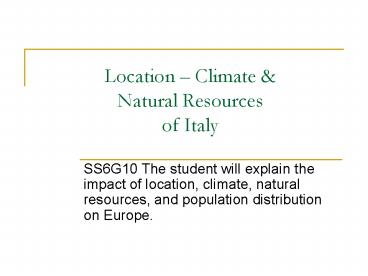Location - PowerPoint PPT Presentation
1 / 25
Title:
Location
Description:
Location Climate & Natural Resources of Italy SS6G10 The student will explain the impact of location, climate, natural resources, and population distribution on ... – PowerPoint PPT presentation
Number of Views:50
Avg rating:3.0/5.0
Title: Location
1
Location Climate Natural Resourcesof Italy
- SS6G10 The student will explain the impact of
location, climate, natural resources, and
population distribution on Europe.
2
Location of Italy
- Italy is a country in southern Europe. It is on a
long, boot-shaped peninsula. The peninsula is
surrounded on three sides by the Mediterranean
Sea. The northern border of Italy is in the Alps.
In this region, Italy shares a border with
France, Switzerland, Austria, and Slovenia. Italy
is about twice the size of the state of Georgia,
but it has seven times as many people.
3
(No Transcript)
4
- Seven out of ten people in Italy live in urban
areas. The largest urban areas are Rome, Naples,
Milan, and Turin. About half of the people in
Italy live in the most northern one-third of the
country.
5
Rome
6
Naples
7
Milan
8
Turin
9
- Islands and mountains affect life in Italy. The
Apennine Mountains are like a backbone across
Italys length, stretching over six hundred
miles. The mountains affect where people live and
how they transport people and goods. Two large
islands in the Mediterranean are a part of Italy.
The island of Sicily is located a few miles west
of the tip of the boot of Italy. The island of
Sardinia is a bit further away.
10
- It lies about two hundred miles west of the main
part of Italy.
11
Sicily, Italy
12
Sardinia, Italy
13
- Italys location on the Mediterranean Sea affects
trade with other countries. Italy has a long
history of shippin goods to and from other
countries in Europe and Asia. Merchants took
advantage of Italys location to trade goods from
Africa, Asia, and Europe. Today, there are seven
major airports and about one hundred smaller
ones. Eight major seaports can handle the largest
ships on the sea. Excellent highways, bridges,
and tunnels connect Italy with their neighbors to
the north.
14
Climateof Italy
- Most of Italy has a Mediterranean climate. The
Mediterranean Sea surrounding Italy keeps the
temperature comfortable most of the year. Summer
skies are generally clear, and rain is rare in
summer. Dry summers are one of the main
characteristics of this climate. Winters are
usually cloudy and rainy. The sea helps keep the
temperatures from getting too hot in summer and
too cold in winter.
15
- The Alps block cold air moving from the north.
The hot, dry air of the Sahara Desert plays a
role in Italys climate. It expands from the
south sending warm dry air into Italy for much of
the year. Not all of Italy has the same kind of
climate. The mountains have a climate that
changes with altitude. The Alps and Apennines
have snowy winters. Their temperature is usually
cooler than the temperature in lower elevations.
He south is drier than the north. Northern Italy
has enough rain for growing crops. Southern Italy
is much drier. It only gets about half as much
rain as northern Italy.
16
Natural Resources of Italy
- Italy has few mineral resources. Natural gas is
the most valuable mineral resource found in
Italy. It is used to help supply the countrys
energy needs. Marble and granite are available.
These are used in the construction of buildings
and artwork. Coal, mercury, zinc, and potash are
other minerals found in Italy.
17
- Arable land is important in Italy. Small farms
cover much of the country. Grapes and olives are
important crops. Italy is one of the worlds top
win-making countries because of its excellent
grape crop. - The sea is an important resource, too. The long
coastline allows for more than eight hundred
ports for fishing boats. About 50,000 Italians
make their living as fishermen. Anchovies and
sardines are two fish important to the economy.
Italian fishermen also gather sponges and coral.
18
Grape Vineyardin Italy
19
Olivesof Italy
20
Olivesprocessed for Olive Oil
21
QuizYourself
- 1. What geographic feature makes it more
difficult for Italian merchants to trade with
countries north of Italy? - a. Alps Mountains
- b. Apennine Mountains
- c. Mediterranean Sea
- d. Sardinia
22
- 2. What has helped Italian merchants become
successful traders? - a. the location of the Alps, which are a defense
against other countries - b. the location on the Mediterranean Sea with
access to Africa, Asia, and Europe - c. the islands of Sicily and Sardinia, which are
not far from the coast of western Italy - d. the warm air from the Sahara Desert, which
creates a warm, dry summer for most of Italy
23
- 3. Which condition is NOT a characteristic of
Italys Mediterranean climate? - a. dry summers
- b. long, cold winters
- c. clear, blue summer skies
- d. mild temperatures all year
24
- 4. Which industry is MOST helped by Italys
arable land and good amounts of rainfall? - a. Wine making
- b. natural gas production
- c. marble and granite mines
- d. fishing fleets on the Mediterranean Sea
25
- See chart Comparing Italy and Germany
- A Word Document































